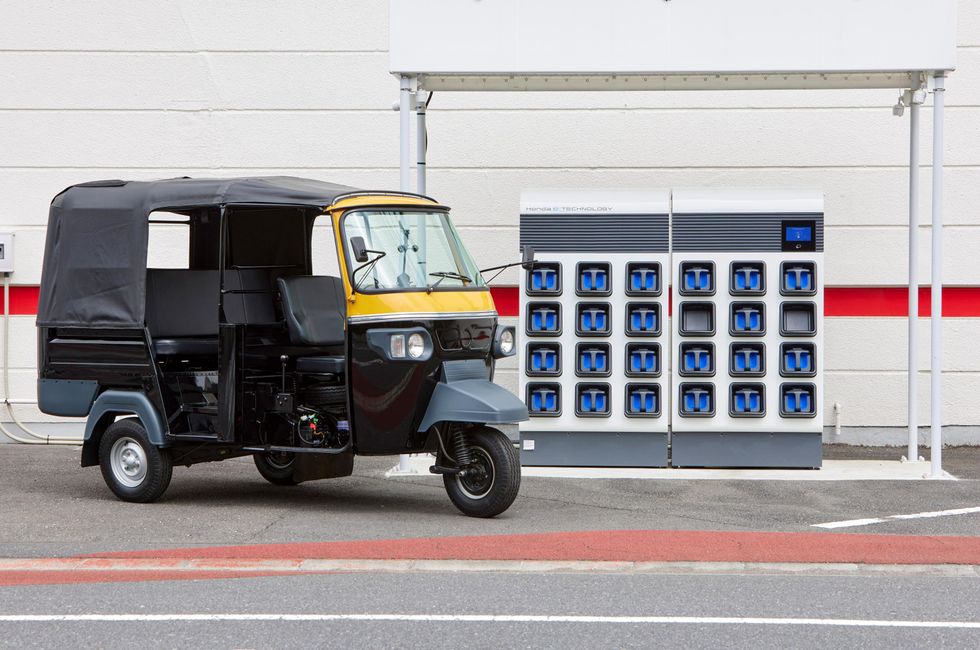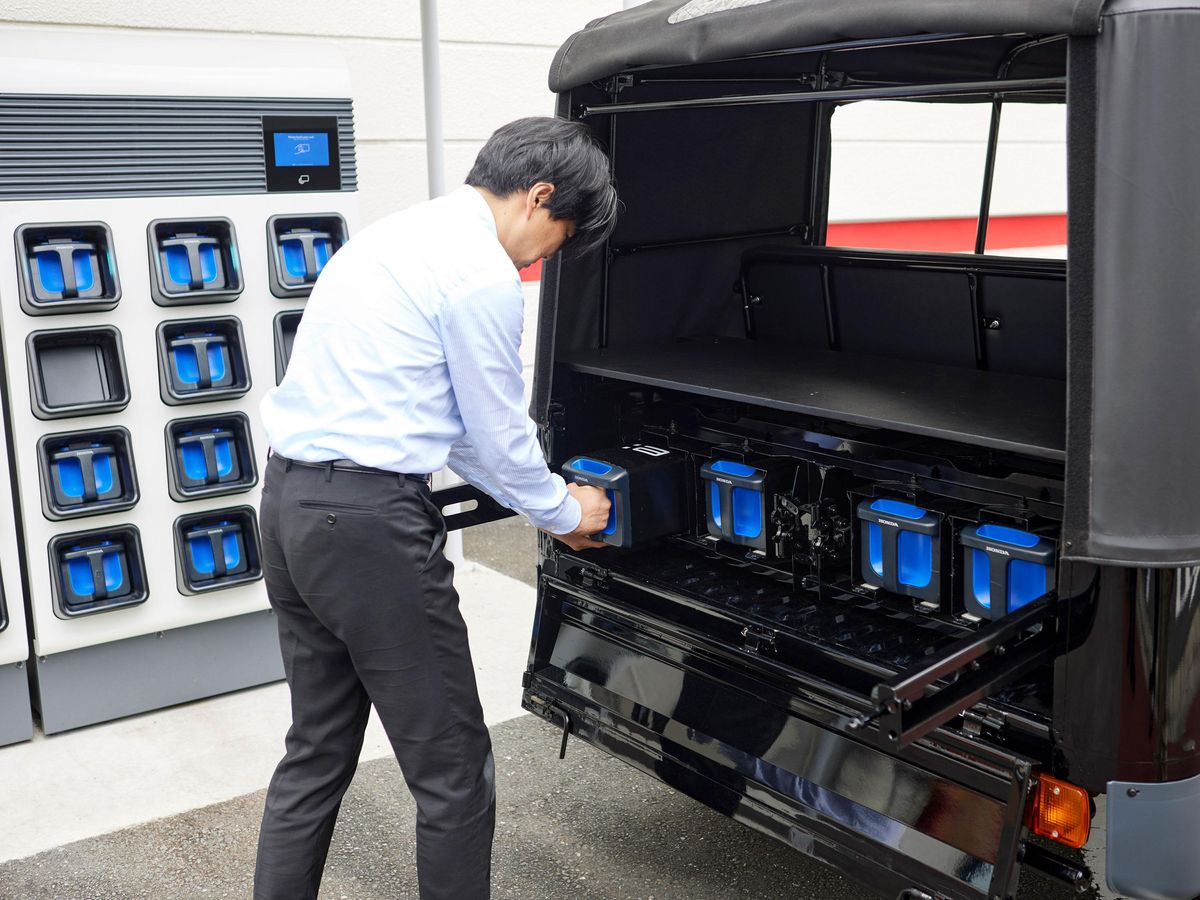Spurred on by the triple threats of CO2 emissions, air pollution, and fluctuating oil prices, governments around the world are encouraging auto manufacturers to replace vehicles using internal combustion engines with electrically driven power trains. India, with a surging economy and the world’s dirtiest air, is no exception. The Indian government is undertaking “a number of initiatives to promote manufacturing and adoption of electric vehicles,” such as providing tax incentives to manufacturers and subsidies to purchasers of e-vehicles, including electric three-wheelers or e-rickshaws.
There are over 8 million three-wheelers used by the masses for cheap taxi rides on India’s clogged roads, and the majority are powered by engines employing environmentally unfriendly compressed natural gas or lead-acid batteries. Honda Motor Co., hoping to take advantage of the central and local government incentives, is looking to tap into this shift to electric vehicles with a new mobile battery sharing service. On 2 December, it established Honda Power Pack Energy India Private Ltd. in Bengaluru (Bangalore), southern India, where the business will kick off in the first half of next year. The new subsidiary will also work with e-rickshaw OEM manufacturers and provide technical support to integrate its batteries–which will be made in India–into these vehicles.
“Transportation is still responsible for 24 percent of the world’s direct CO2 emissions from fuel combustion,” says Professor Anita Ho-Baillie, Deputy Director of the University of Sydney's Nano Institute, in Sydney, Australia. “So we need to seize every opportunity to electrify vehicles.” And EVs have other advantages, she adds, “including immediate and smooth acceleration, while electric motors are quieter and have fewer moving parts compared to combustion engines.”
Honda introduced its first mobile battery pack in 2017; in 2019, the automaker began testing it in motorbikes and scooters in the Philippines, Indonesia, and Japan. Testing in India began this February using 30 e-rickshaws driven for a total of 200,000 km. “We learned a lot about the issues involved in turning it into a business,” says Yoshihiro Nakajima, general manager of the Mobile Power Pack project.
Not surprisingly, the three biggest issues were the lengthy time taken to charge the batteries, the short driving range they provide, and high cost. Honda’s answer to the first two problems is its lithium-ion Mobile Power Pack (MPP) battery, working in conjunction with the Mobile Power Pack Exchanger. The Exchanger consists of 12 charged MPP batteries in compartmentalized charging chambers that allow a depleted battery to be swapped for a fully energized replacement in a matter of minutes. A maximum of seven exchangers can be hooked together in a single installation.
In the Honda scheme, an e-rickshaw runs on four mobile power pack batteries. Each pack measures 29.8 x 17.7 x 15.6 cm, weighs just over 10 kg, and comes with handles. Nakajima says the replacement procedure can exchange two of the four batteries in one minute or less. Nakajima has even presented video evidence to back up this claim. The e-rickshaw driver touches the exchanger with a subscriber ID card, and the Exchanger indicates which two charged batteries to remove. These are plugged into the nearby vehicle, and the depleted batteries are then inserted into the Exchanger for recharging. The procedure is repeated for the other two MPPs.
The concept is beneficial for both users and the suppliers, says Ho-Baillie. “It saves time and makes the drivers’ job much easier because they don’t have to stand around waiting for the batteries to be charged. As for the suppliers, portable battery packs mean they have more flexibility in terms of where they build their charging infrastructures.”
Honda’s latest iteration of the battery, MPP e, is rated at 50.3 volts, with a capacity of 1.3 kilowatt-hours, and a charging time of 5 hours. With Asian tropical climates in mind, the battery is designed to dissipate heat and prevent discharge deterioration in high temperatures. It is also resistant to water, vibration, and shock under normal operating conditions. A built-in control unit uses sensors to keep tabs on internal conditions anddocument usage patterns for the Exchanger to assess.
“The cylindrical cells used in the battery pack are the same as those widely used in electronic products such as personal computers,” says Nakajima. “Because their efficiency is improving year by year, we can get the benefits of cell evolution without changing the outer shape of the battery pack, and so maintain backward compatibility.”
An e-rickshaw can travel just 60 km before needing to swap the batteries, which will presumably require numerous visits to charging stations throughout the day. To lessenthe toll taken by what might otherwise be a draining chore, Honda will provide drivers with a smart phone app that displays a map indicating the locations of all the charging stations in the area, together with the number of charged batteries available at each station. And by initially limiting the service first to Bengaluru and then Mumbai, Nakajima says they can ensure there will be sufficient stations for the service to work smoothly from the start. He adds that during the earlier testing period, they found that having three stations within a 5-kilometer radius met operational goals.

To tackle the issue of high cost, Honda points out that the specifications of the MPP conform to the safety standard UN R136 adopted by the United Nations. And to promote its common use and reduce costs through economies of scale, Honda has helped create two consortia: one covering the Japanese market with members Yamaha, Suzuki and Kawasaki, and the other for the European market, with KTM, Piaggio and Yamaha on board.
The company is also exploring additional ways to expand the use of its battery pack, such as in small construction machines, in homes as back-up power for electric appliances, as well as establishing battery- sharing systems for civil engineering and construction industries.
Portable power packs also mean “you can ‘transport’ energy from and to different localities,” says Ho-Baillie. “Should the suppliers want to charge the batteries using renewables, they can strategically build charging stations in places where it is windy and/or sunny. Charging the batteries using renewables instead of electricity from coal-fired-power stations would further reduce CO2 and toxic emissions.”
This article appears in the February 2022 print issue as “Battery Swapping Electrifies India's Rickshaws."
- The Top 10 EV Battery Makers - IEEE Spectrum ›
- EV Battery Swapping's First Real Test - IEEE Spectrum ›
- How Is This A Good Idea?: EV Battery Swapping - IEEE Spectrum ›
- This Car Charger Bot Will Hold Your Spot - IEEE Spectrum ›
- Building a Fleet of Personal EVs in Kenya - IEEE Spectrum ›
- Yamaha Joins Global Move to Battery Swaps for E-bikes - IEEE Spectrum ›



